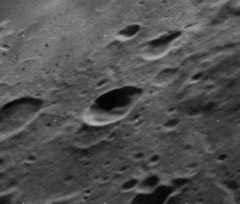 Oblique Lunar Orbiter 5 image | |
| Coordinates | 46°36′S159°12′W / 46.6°S 159.2°W |
|---|---|
| Diameter | 18 km |
| Depth | Unknown |
| Colongitude | 160° at sunrise |
| Eponym | Don O. Hendrix |
Hendrix is a small lunar impact crater that is located on the Moon's far side, deep in the southern hemisphere. Hendrix lies about a crater diameter to the south-southwest of the crater White, just beyond the outer rim of the enormous walled plain Apollo. This is a roughly circular, bowl-shaped crater. The rim is sharp-edged and not noticeably eroded. The interior is relatively featureless.
The crater is named after Don Hendrix. [1]